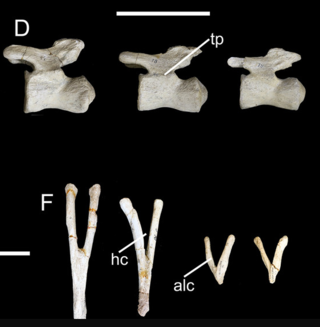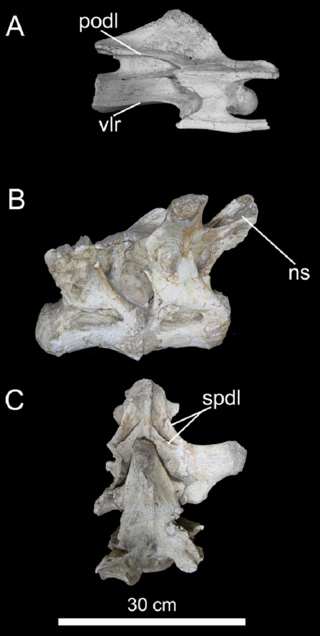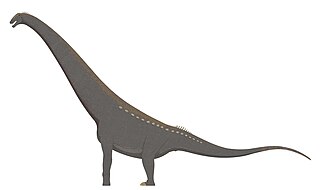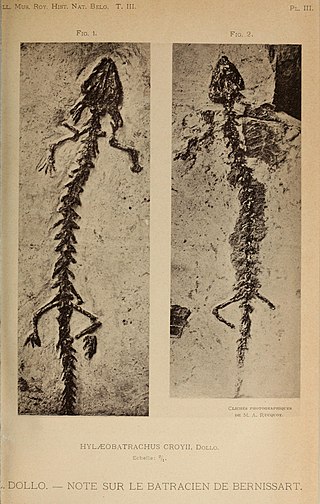
Baurutitan is a genus of sauropod dinosaur that lived during the Late Cretaceous in what is now Brazil. The type species, Baurutitan britoi, was described in 2005 by Kellner and colleagues, although the fossil remains had already been discovered in 1957. Baurutitan is classified as a lithostrotian titanosaur, and is distinguished from related genera based on its distinctive caudal vertebrae. This South American dinosaur was found in the Serra da Galga Formation near Uberaba, in the Brazilian state of Minas Gerais.

Trigonosaurus, is a genus of saltasaurid dinosaurs from the Maastrichtian Serra da Galga Formation of Brazil. The type species, Trigonosaurus pricei, was first described by Campos, Kellner, Bertini, and Santucci in 2005. It was based on two specimens, both consisting mainly of vertebrae. The two specimens were originally believed to have come from the same individual. However, one specimen was described as the holotype of Caieiria in 2022, while the holotype may have instead come from Baurutitan. Before its description, it was known as the "Peirópolis titanosaur", after the place it was found.

Beelzebufo is a particularly large species of prehistoric frog described in 2008. Common names assigned by the popular media include devil frog, devil toad, and the frog from hell.

Uberabatitan is a genus of titanosaurian sauropod dinosaur from the Late Cretaceous of Brazil. It is known from bones including neck, back, and tail vertebrae, pelvic bones, and limb bones. These fossils were found in the uppermost portion of the Maastrichtian-age Serra da Galga Formation of the Bauru Group, in Uberaba, Minas Gerais. The type species, described by Salgado and Carvalho in 2008, is U. ribeiroi. To date, it is the most recent titanosaur from Bauru Group rocks; other titanosaurs from the Bauru Group, including Baurutitan and Trigonosaurus, come from lower levels.

Sphagesaurus is an extinct genus of sphagesaurid notosuchian crocodylomorph from the Late Cretaceous of southwest São Paulo, southern Brazil.
Aralobatrachus is an extinct genus of prehistoric amphibian known from Uzbekistan.
Apricosiren is an extinct genus of prehistoric salamander. It is known from the Berriasian aged Lulworth Formation in southern England.
Altanulia is an extinct genus of prehistoric amphibian.
Albionbatrachus is an extinct genus of prehistoric frogs from England and Romania. Two species are recognized: While previously synonymised with Palaeobatrachus, it is now considered a distinct palaeobatrachid genus based on characters of the frontoparietals.
Eoxenopoides is an extinct genus of prehistoric frogs. It is known from Banke, a Maastrichtian/Selandian crater lake mudstone in South Africa.

Hylaeobatrachus is an extinct genus of prehistoric salamander, known from the Early Cretaceous of Europe. The type species H. croyii is known from the Sainte-Barbe Clays Formation at the Iguanodon locality of Belgium, and was described by Louis Dollo. An unnamed Hylaeobatrachus-like taxon has also been reported from Las Hoyas, Spain. Both localities are of Barremian age. Hylaeobatrachus belongs to the crown group of modern salamanders, though its exact relationship with modern salamander groups is uncertain. It was neotenic, llike some modern salamanders.
Gobiates is an extinct genus of prehistoric amphibians. Fossils have been found in the Barun Goyot and Djadokhta Formations of Mongolia, the Bissekty Formation of Uzbekistan and the Paluxy and Twin Mountains Formations of Texas. The following species are recognized:
Nezpercius is an extinct genus of prehistoric amphibian.
Macropelobates is an extinct genus of prehistoric frogs. It was described by Gladwyn Kingsley Noble based on material from Oligocene of Mongolia.
Procynops is an extinct genus of prehistoric amphibian.
Procerobatrachus is an extinct genus of prehistoric amphibian. It was described based on material from Uzbekistan.
Paleoamphiuma is an extinct genus of prehistoric salamanders. It is known from the Green River Formation in Wyoming, the United States.
Scotiophryne is an extinct genus of prehistoric amphibian.

Caieiria is a genus of titanosaurian dinosaur from the Late Cretaceous Serra da Galga Formation of Brazil. The type and only species is Caieiria allocaudata.
The Serra da Galga Formation is a geological formation in Minas Gerais state of southeastern Brazil. Its strata date back to the Maastrichtian, and are part of the Bauru Group. It was originally considered a member of the Marília Formation.






